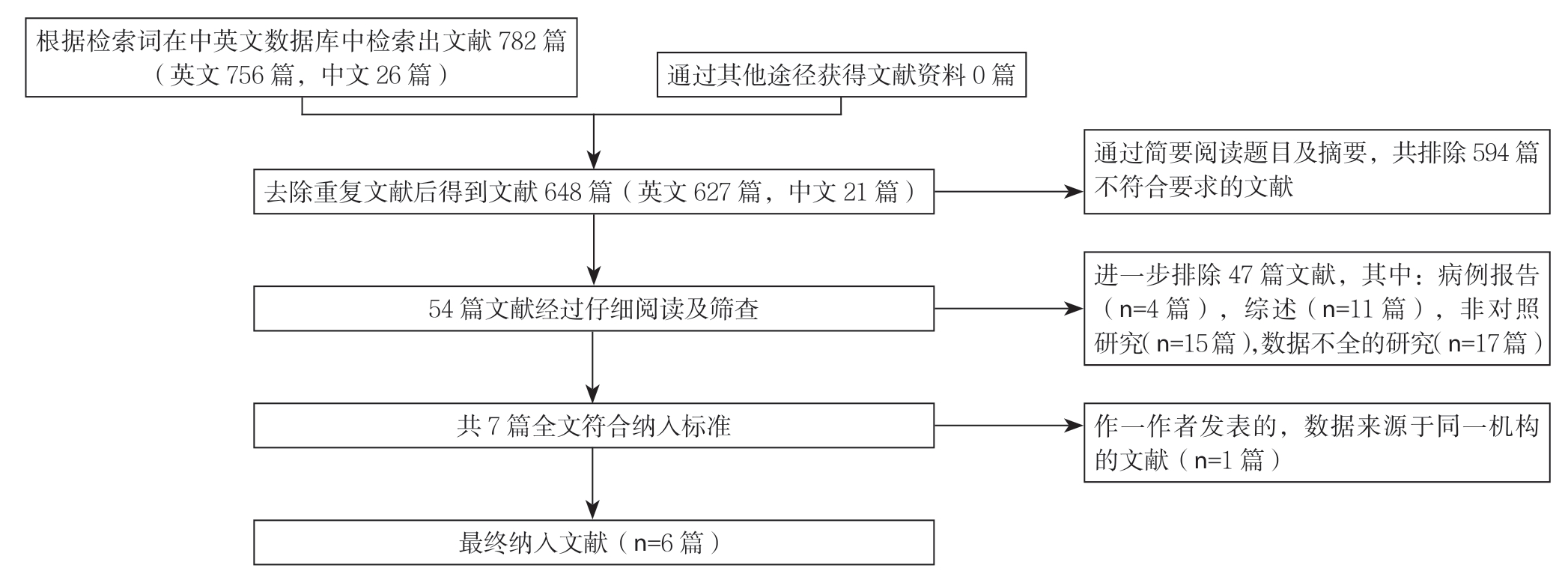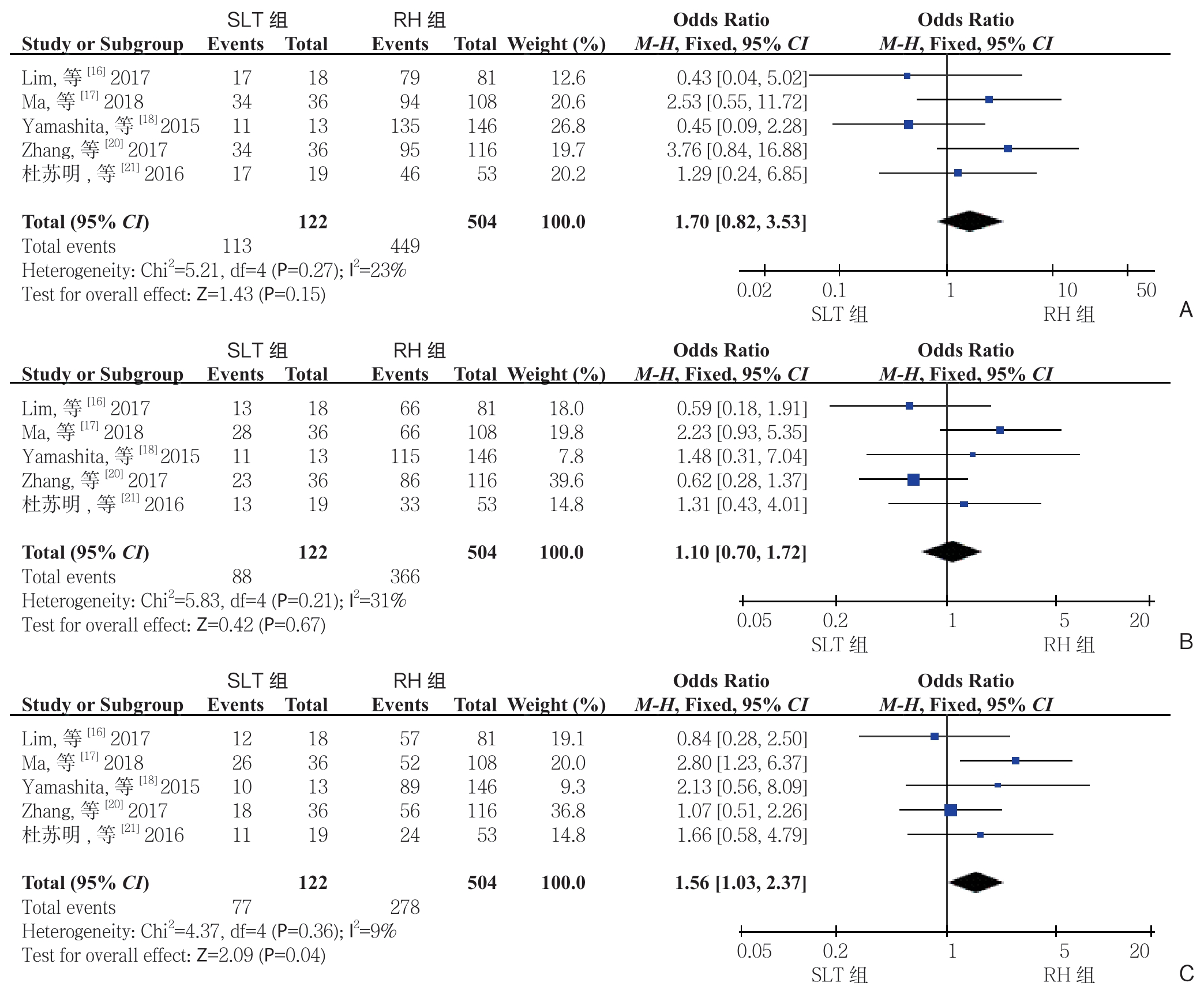原发性肝细胞癌(hepatocellular carcinoma,HCC,以下简称肝癌)是全球范围内常见的恶性肿瘤,其发病率和病死率分别居于恶性肿瘤的 第6位和第4位[1]。目前,外科手术(肝移植和肝切除)是肝癌最有效的根治性方法[2-3]。肝移植是唯一能同时根治肝内肿瘤和肝硬化的手段,其总体疗效优于肝切除治疗[4]。但供肝来源短缺、治疗费用高昂等因素,严重限制了肝移植的应用与发展。因此,肝切除是肝癌首选的治疗方式,但术后总体疗效不佳,约70%的患者在5年内出现肿瘤复发[5-6]。复发性肝癌常用的治疗方法包括再次肝切除术(repeat hepatectomy,RH)、区域性局部治疗、全身性治疗等[7-8]。对于可切除的复发性肝癌,RH是目前最主要的治疗方式,术后5年总体生存率约50%~60%,但无瘤生存率显著降低[9-11]。
Majno等[12]于2000年首先提出了挽救性肝移植(salvage liver transplantation,SLT)概念,即对肝癌患者先采取肝切除治疗,术后肝癌复发或发生肝功能衰竭时再行肝移植。近年来,SLT逐渐被大家认可,有研究[13-14]报道,SLT治疗复发性肝癌是安全有效的,甚至可达到与早期肝移植相似的预后。然而,比较SLT和RH治疗复发性肝癌的报道较少、研究结果不一,目前尚不清楚哪种治疗方式更有利于患者。因此,本研究旨在系统回顾已发表的文献,通过Meta分析评估SLT与RH在治疗术后复发性肝癌中的有效性和安全性,从而为临床实践提供更多的循证依据。
1 资料与方法
1.1 检索策略
检索的英文数据库有PubMed、Cochrane library、Embase,中文数据库有知网、万方、维普,检索时间为建库起至2019年8月,中文检索词包括:复发性肝细胞癌、挽救性肝移植、抢救性肝移植、再次肝切除术。英文检索词包括:Recurrent Hepatocellular Carcinoma,Salvage Liver Transplantation,Repeat Hepatectomy,Repeat Liver Resection。根据检索所得到文献的参考文献进行再检索,以提高符合条件的文献检出率。
1.2 纳入与排除标准
纳入标准:⑴ 研究对象为肝切除术后复发性肝细胞癌的患者;⑵ 文献报道了SLT和RH在治疗复发性肝癌疗效方面的比较;⑶ 观察指标至少包括术中出血量、住院时间、术后并发症、围手术期病死率、总体生存率、无瘤生存率等指标中的一项;⑷ 如果研究是基于重叠的患者,则纳入最新的或完整的研究,语种包括中文和英文。排除标准:⑴ 合并肝外转移者,或者可能影响研究结果的其他疾病;⑵ 单独研究SLT或RH治疗复发性肝癌的文献;⑶ 单个研究单种治疗病例数<10例; ⑷ 综述、评论、病例报告等非对照性研究的文献。
1.3 数据提取与质量评估
由2位作者独立提取纳入研究的数据并比较结果。如有分歧则通过讨论或征求第3位作者协助解决。采用标准化数据采集方法,仔细提取数据。每项研究收集的数据包括:作者、发表年份、国家、病例人数、平均年龄、男女比例、肿瘤大小。结局指标包括:术中出血量、住院时间、术后并发症、围手术期病死率、总体生存率以及无瘤生存率。采用文献质量评价量表(Newcastle-Ottowa Scale,NOS)评估回顾性队列研究(retrospective cohort study,RCS),分别从患者选择、研究组的可比性及结局评估3个方面进行文献质量评分,总分9分,当得分≥5分认为是高质量研究[15]。
1.4 统计学处理
采用Revman5.3软件进行统计学分析。计数资料采用比值比(odds ratio,OR)及其95%可信区间(confidence interval,CI)表示,计量资料采用均数差(mean difference,MD)及其95%CI表示。纳入研究结果间的异质性采用I2检验分析,若各研究间无明显异质性(I2<50%,P>0.10),采用固定效应模型(fixed effect,FE)合并效应量;若存在明显异质性(I2>50%,P<0.10),则采用随机效应模型(random effect,RE)分析。对于无法定量合成的指标,通过描述性分析予以定性评价。P<0.05为差异有统计学意义。
2 结 果
2.1 纳入文献基本特征及质量评价
共检索出文献782篇,最终纳入6篇文献[16-21],其中1篇中文文献,5篇英文文献,均为回顾性队列研究,共650例患者(SLT组134例,RH组516例)。文献筛选流程见图1,纳入文献的基本特征见表1,质量评价结果见表2,纳入研究均为高质量研究。

图1 文献筛选流程图
Figure1 Literature screening process
表1 纳入研究的基本特征
Table1 Characteristics of the included studies

作者及年份 国家 治疗方式 样本量年龄(岁) 性别(男/女) 肿瘤大小(cm)Lim,等[16] 2017 法国 SLT 1858±914/42.7±2.2 RH 8162±967/142.0±0.9 Ma,等[17] 2018 中国 SLT 3655(40~65) 29/73.0(0.3~7.0)RH 10853(23~78) 79/293.0(0.6~10.6)Yamashita,等[18] 2015日本 SLT 1356.2±5.610/32.5±1.1 RH 14668.2±9.699/471.9±0.9 Ng,等[19] 2008 中国 SLT 1251(11~60) 12/03.0(1.0~5.0)RH 1253(24~65) 未报道 2.0(0.5~4.5)Zhang,等[20] 2017 中国 SLT 3647.0±10.231/54.4±3.9 RH 11650.2±11.799/173.1±1.9杜苏明,等[21] 2016 中国 SLT 1951.5±8.517/23.5±1.0 RH 5356.2±9.744/93.3±1.0
表2 纳入文献的质量评估
Table2 Quality assessment of the included studies

注:1 个★代表1分;1 为暴露队列的代表性;2 为非暴露队列的选择;3 为暴露因素确定;4 为研究起始前尚无要观察的结局事件;5 为基于设计或分析所得的队列的可比性;6 为结局事件的评价;7 为随访时间足够长;8 为随访的完整性
Note:One asterisk standing for 1 score; 1 representing the representativeness of the exposed cohort; 2 representing the selection of nonexposed cohort; 3 representing the determination of the exposure factors; 4 representing no outcome events requiring observation from the beginning of the study; 5 representing comparability across cohorts based on the design or analysis; 6 representing the assessment of the outcome events; 7 representing enough follow-up time; 8 representing the integrity of blinded follow-up examinations
第一作者 对象的选择 群体可比性 结局评估 分数(分)12345678 Lim,等[16] 2017 ★ ★ ★ ★ ★ ★ ★ ★ 8 Ma,等[17] 2018 ★ ★ ★ ★ ★★ ★ ★ — 8 Yamashita,等[18] 2015★ ★ ★ ★ ★ ★ ★ ★ 8 Ng,等[19] 2008 ★ - ★ ★ ★ ★ ★ — 6 Zhang,等[20] 2017 ★ ★ ★ ★ ★ ★ ★ — 7杜苏明,等[21] 2016 ★ ★ ★ ★ ★ ★ ★ — 7
2.2 Meta 分析结果
2.2.1 总体生存率 纳入文献中有5 篇[16-18,20-21]比较了1、3、5年总体生存率。⑴ 1年总体生存率:各研究间无明显异质性(P=0.27,I2=23%),采用固定效应模型分析。Meta 分析结果显示,SLT 组与RH 组1年总体生存率差异无统计学意义(OR=1.70,95% CI=0.82~3.53,P=0.15)(图2A)。⑵ 3年总体生存率:各研究间无明显异质性(P=0.21,I2=31%),采用固定效应模型分析。Meta 分析结果显示,SLT 组与RH 组3年总体生存率差异无统计学意义(OR=1.10,95% CI=0.70~1.72,P=0.67)(图2B)。⑶ 5年总体生存率:各研究间无明显异质性(P=0.36,I2=9%),采用固定效应模型分析。Meta 分析结果显示,SLT 组5年总体生存率高于RH 组,差异有 统 计学意义(OR=1.56,95% CI=1.03~2.37,P=0.04)(图2C)。
2.2.2 无瘤生存率 纳入文献中有5 篇[16-18,20-21]比较了1、3、5年无瘤生存率。⑴ 1年无瘤生存率:各研究间无明显异质性(P=0.88,I2=0%),采用固定效应模型分析。Meta 分析结果显示,SLT 组1年无瘤生存率明显优于RH 组,差异有统计学意义(OR=5.91,95% CI=3.16~11.05,P<0.00001)(图3A)。⑵ 3年无瘤生存率:各研究间无明显异质性(P=0.21,I2=32%),采用固定效应模型分析。Meta 分析结果显示,SLT 组3年无瘤生存率明显优于RH 组,差异有统计学意义(OR=3.98,95% CI=2.57~6.16,P<0.00001) (图3B)。⑶ 5年无瘤生存率:各研究间存在明显异质性(P=0.02,I2=67%),采用随机效应模型分析。Meta 分析结果显示,SLT 组5年无瘤生存率明显优于RH 组,差异有统计学意义(OR=4.37,95% CI=2.03~9.44,P=0.0002)(图3C)。

图2 总体生存率比较
Figure2 Comparison of the overall survival rate rate
A:1年总体生存率;B:3年总体生存率;C:5年总体生存率
A:1-year overall survival rate; B:3-year overall survival rate; C:5-year overall survival
2.2.3 术后并发症 纳入文献中有4 篇[17-20] 比较了术后并发症情况,各研究间无明显异质性(P=0.22,I2=33%),采用固定效应模型分析。Meta 分析结果显示,SLT 组术后并发症发生率高于RH 组,差异有统计学意义(OR=4.67,95% CI= 2.72~8.01,P<0.00001)(图4)。
2.2.4 围手术期病死率 纳入文献中有5 篇[16-19,21]比较了围手术期病死率,各研究间存在明显异质性(P=0.10,I2=53%),采用随机效应模型分析。Meta 分析结果显示,SLT 组与RH 组围手术期病死率差异无统计学意义(OR=3.92,95% CI= 0.41~37.80,P=0.24)(图5)。
2.2.5 术中出血量及住院时间 纳入文献中有2 篇 比较了术中出血量,Yamashita 等[18]报道了SLT组与RH组的术中出血量分别为(24690± 59014.4)mL 和(596.3±764.9)mL,差异有统计学意义(P<0.0001);Zhang 等[20] 报道了SLT 组与RH 组的术中出血量分别为(1177.78±552.45)mL 及(264.6±311.8)mL,差异有统计学意义(P<0.001)。1 篇文献[20]报道了住院时间,SLT 组与RH 组住院时间分别为(35±21)d 和(20±22)d,差异有统计学意义(P=0.018)。

图3 无瘤生存率比较
Figure3 Comparison of the disease-free survival rate disease-free survival rate
A:1年无瘤生存率;B:3年无瘤生存率;C:5年无瘤生存率
A:1-year disease-free survival rate; B:3-year disease-free survival rate; C:5-year

图4 术后并发症比较
Figure4 Comparison of the postoperative complications

图5 围手术期病死率比较
Figure5 Comparison of the perioperative mortality
2.3 敏感度分析及发表偏倚
异质性检验表明,5年无瘤生存率(P=0.02,I2=67%)、围手术期病死率(P=0.10,I2=53%)存在明显异质性,故使用逐一剔除文献法进行敏感度分析。在剔除过程中,每组异质性变化不明显,且结局指标结果基本一致,表明该分析结果较为稳定。该Meta分析各项结局指标纳入的文献均<10篇,故未使用漏斗图来检测发表偏倚。
3 讨 论
肝癌复发是影响肝癌患者预后的重要因素,也是肝癌治疗领域面临的难点问题[22]。尽管对复发性肝癌强调采取多学科综合治疗,但临床上RH仍是首选治疗手段[23]。然而,复发性肝癌患者的残余肝脏容积不足、基础肝功能受损以及严重的腹腔粘连都为RH提出了挑战,导致只有不足30%的患者适合RH[24]。近十几年来,肝移植逐渐在肝癌复发的治疗中得到应用。SLT的治疗策略首先由Majno等[12]提出,联合肝切除术和肝移植两种治疗方式,其优点在于:既降低了患者等待肝移植期间肿瘤进展风险,又一定程度上缓解了供肝匮乏问题、减少肝移植需求,使有限的供肝资源分配更为合理,同时推迟了免疫抑制剂的使用[25]。相关报道表明了SLT治疗肝癌复发的安全性和有效性[13-14,26-27], 但也有部分报道提出了质疑,Shan等[28]的研究发现,与一期肝移植相比,SLT术后总体生存率以及无瘤生存率均较低。近来一项Meta分析[29]结果同样提示SLT的累积生存时间、无病生存率较一期肝移植低。同时SLT还存在一定争议:由于患者有肝切除手术史,解剖结构的改变、严重的腹腔粘连等增加了SLT的手术风险及难度;并且部分患者的复发病灶不局限于肝内,导致丧失肝移植的机会[30]。因此,SLT治疗复发性肝癌仍存在诸多分歧。本研究通过系统评价的方法,综合已发表的数据,分析比较SLT和RH在治疗复发性肝癌中的有效性和安全性。
本Meta分析结果显示,与RH比较,SLT在复发性肝癌的治疗中具有一定的优势:⑴ SLT可以明显改善患者术后1、3、5年无瘤生存率。其原因在于全肝切除更有助于彻底清除肿瘤,同时治疗潜在的肝脏病变(如肝硬化、门静脉高压),预防残余肝脏再次发生原发性肝癌[31]。且该结论与纳入文献[16-18,20-21]研究结果基本一致。⑵ SLT组患者5年总体生存率较高。由于RH术后复发率更高,而肝癌再次复发后手术切除的可能性降低,其治疗方式以姑息性为主,一定程度上影响了患者的长期生存[17]。但在术后并发症发生率、术中出血量及住院时间等方面,RH组要明显优于SLT组。这与两种手术方式的不同密切相关,相对于肝切除术,肝移植手术更为复杂,并且创伤更大,从而导致术中出血量较多,术后并发症发生率较高,住院时间较长。两种治疗方式在1、3年总体生存率以及围手术期病死率上无显著差别。Chan等[32]的研究评估了SLT、RH和射频消融对复发肝癌的疗效,结果表明SLT组的无瘤生存率显著高于RH组和射频消融组,但SLT组和RH组的5年总体生存率相当,均明显优于射频消融组。Ma 等[17]通过倾向评分匹配的方法比较了SLT与RH对复发性肝癌的疗效,研究发现SLT组的5年无瘤生存率及 5年总体生存率均明显优于RH组,与本Meta分析结果类似。鉴于这2篇文献来源于相同的通讯作者及机构,可能有重叠的资料,故只纳入了Ma等[17]的最新研究。Wang等[33]的Meta分析中比较了SLT与非移植手段(包括RH、射频消融、肝动脉化疗栓塞等)治疗复发性肝癌的疗效,表明SLT组的无瘤生存率及5年总生存率均明显优于非移植手段组;亚组分析示SLT组的3、5年无瘤生存率显著高于RH组,而在总体生存率方面,两者并无统计学差异。
虽然,本研究表明SLT治疗复发性肝癌的可行性及有效性,但只适用于部分患者。目前尚无复发性肝癌行SLT的统一入选标准,各移植中心多参考Milan标准[34](即单发肿瘤,直径≤5 cm,或多发肿瘤、数目≤3个且最大直径≤3 cm)选择患者[30]。按此标准筛选,SLT可获得与一期肝移植相当的长期预后[35]。然而,有研究[36]发现,只有25%左右的复发性肝癌患者符合Milan标准,若严格参照该入选标准,则意味着约75%的患者将失去SLT的机会。 此外,还有UCSF标准、杭州标准等不同的肝移植选择标准。Hu等[37]研究表明,符合杭州标准的SLT患者与在Milan标准内的SLT患者相比,两组的总体生存率及无瘤生存率无显著差异,但杭州标准可增加患者的入选率(56.6% vs.30.1%),明显扩大了SLT的适宜人群。因此,对于复发性肝癌行SLT的入选标准不应局限于Milan标准,必要时应结合患者全身情况、肿瘤生物学行为以及供体情况等综合考虑,使更多的复发性肝癌患者受益于SLT[30]。
然而,本研究存在一定局限性。首先,纳入文献均为回顾性研究,且样本量较小,可信度降低。第二,因本研究纳入文献小于10篇,故未做漏斗图来评估发表偏倚。第三,分析5年无瘤生存率和围手术期病死率时,研究间存在明显异质性,故使用了随机效应模型,可能削弱总体结果的证据。因此,该研究结果还需要多中心、大样本、高质量的随机对照试验予以验证。
综上所述,对于复发性肝癌的治疗,RH具有术中出血较少、术后并发症发生率较低、住院时间较短等优势,但SLT可明显改善术后无瘤生存率,获得较好的长期预后。因此,在治疗方式的选择上应结合患者自身情况及肝源短缺现状,制定具有个性化的治疗方案,以提高患者的生活质量和预后。
[1] Bray F,Ferlay J,Soerjomataram I,et al.Global cancer statistics 2018:GLOBOCAN estimates of incidence and mortality worldwide for 36 cancers in 185 countries[J].CA Cancer J Clin,2018,68(6):394–424.doi:10.3322/caac.21492.
[2] 郑树森,程启阳,耿磊,等.肝癌肝移植术后肝癌复发研究新进展[J].中国普通外科杂志,2019,28(7):773–778.doi:10.7659/j.issn.1005–6947.2019.07.001.
Zheng SS,Cheng QY,Geng L,et al.Tumor recurrence after liver transplantation for hepatocellular carcinoma:recent research progress[J].Chinese Journal of General Surgery,2019,28(7):773–778.doi:10.7659/j.issn.1005–6947.2019.07.001.
[3] 刘允怡,赖俊雄,刘晓欣.手术切除在肝癌多学科综合治疗中的地位[J].中国实用外科杂志,2014,34(8):677–680.doi:10.7504/CJPS.ISSN1005–2208.2014.08.01.
Liu YY,Lai JX,Liu XX.Status of surgeryin the multidisciplinary treatment of hepatocellular carcinoma[J].Chinese Journal of Practical Surgery,2014,34(8):677–680.doi:10.7504/CJPS.ISSN1005–2208.2014.08.01.
[4] 陈世发,赵礼金.癌发生发展机制的研究进展及其治疗现状[J].中国普通外科杂志,2018,27(7):910–923.doi:10.3978/j.issn.1005– 6947.2018.07.016.
Chen SF,Zhao LJ.Research progress on mechanisms for occurrence of liver cancer and its treatment status[J].Chinese Journal of General Surgery,2018,27(7):910–923.doi:10.3978/j.issn.1005–6947.2018.07.016.
[5] Forner A,Reig M,Bruix J.Hepatocellular carcinoma[J].Lancet,2018,391(10127):1301–1314.doi:10.1016/S0140–6736(18)30010–2.
[6] El-Serag HB.Hepatocellular carcinoma[J].N Engl J Med,2011,365(12):1118–1127.doi:10.1056/NEJMra1001683.
[7] 杨玉兵,张海洋,王建锋.肝细胞癌切除术后复发的RFA微创治疗[J].中国普通外科杂志,2016,25(7):1080–1084.doi:10.3978/j.issn.1005–6947.2016.07.024.
Yang YB,Zhang HY,Wang JF.Effect of minimally invasive RFA treatment of hepatocellular carcinoma recurrence after resection of hepatocellular carcinoma[J].Chinese Journal of General Surgery,2016,25(7):1080–1084.doi:10.3978/j.issn.1005–6947.2016.07.024.
[8] 刘允怡,赖俊雄,刘晓欣.肝癌术后复发治疗方式合理选择[J].中国实用外科杂志,2012,32(10):796–798.
Liu YY,Lai JX,Liu XX.Reasonable option of management approaches for recurrent liver cancer[J].Chinese Journal of Practical Surgery,2012,32(10):796–798.
[9] Fan ST,Mau Lo C,Poon RT,et al.Continuous improvement of survival outcomes of resection of hepatocellular carcinoma:a 20-year experience[J].Ann Surg,2011,253(4):745–758.doi:10.1097/SLA.0b013e3182111195.
[10] Itamoto T,Nakahara H,Amano H,et al.Repeat hepatectomy for recurrent hepatocellular carcinoma[J].Surgery,2007,141(5):589–597.doi:10.1016/j.surg.2006.12.014.
[11] Yoh T,Seo S,Taura K,et al.Surgery for Recurrent Hepatocellular Carcinoma:Achieving Long-term Survival[J].Ann Surg,2019.doi:10.1097/SLA.0000000000003358.[Epub ahead of print]
[12] Majno PE,Sarasin FP,Mentha G,et al.Primary liver resection and salvage transplantation or primary liver transplantation in patients with single,small hepatocellular carcinoma and preserved liver function:an outcome-oriented decision analysis[J].Hepatology,2000,31(4):899–906.doi:10.1053/he.2000.5763.
[13] Guerrini GP,Gerunda GE,Montalti R,et al.Results of salvage liver transplantation[J].Liver Int,2014,34(6):e96–104.doi:10.1111/liv.12497.
[14] Chan DL,Alzahrani NA,Morris DL,et al.Systematic review of efficacy and outcomes of salvage liver transplantation after primary hepatic resection for hepatocellular carcinoma[J].J Gastroenterol Hepatol,2014,29(1):31–41.doi:10.1111/jgh.12399.
[15] Luchini C,Stubbs B,Solmi M,et al.Assessing the quality of studies in meta-analyses:Advantages and limitations of the Newcastle Ottawa Scale[J].World J Meta-Anal,2017,5(4):80.
[16] Lim C,Shinkawa H,Hasegawa K,et al.Salvage liver transplantation or repeat hepatectomy for recurrent hepatocellular carcinoma:An intent-to-treat analysis[J].Liver Transpl,2017,23(12):1553–1563.doi:10.1002/lt.24952.
[17] Ma KW,Chok KSH,She WH,et al.Defining Optimal Surgical Treatment for Recurrent Hepatocellular Carcinoma:A Propensity Score Matched Analysis[J].Liver Transpl,2018,24(8):1062–1069.doi:10.1002/lt.25033.
[18] Yamashita Y,Yoshida Y,Kurihara T,et al.Surgical results for recurrent hepatocellular carcinoma after curative hepatectomy:Repeat hepatectomy versus salvage living donor liver transplantation[J].Liver Transpl,2015,21(7):961–968.doi:10.1002/lt.24111.
[19] Ng KK,Lo CM,Liu CL,et al.Survival analysis of patients with transplantable recurrent hepatocellular carcinoma:implications for salvage liver transplant[J].Arch Surg,2008,143(1):68–74.doi:10.1001/archsurg.2007.15.
[20] Zhang X,Li C,Wen T,et al.Treatment for intrahepatic recurrence after curative resection of hepatocellular carcinoma:Salvage liver transplantation or re-resection/radiofrequency ablation? A Retrospective Cohort Study[J].Int J Surg,2017,46:178–185.doi:10.1016/j.ijsu.2017.09.001.
[21] 杜苏明,张小进,江艺.补救性肝移植和再次肝切除治疗肝癌术后复发的疗效对比[J].局解手术学杂志,2016,25(6):409–412.doi:10.11659/jjssx.03E016097.
Du SM,Zhang XJ,Jiang Y.Comparative effect of salvage liver transplantation and repeated hepatectomy for recurrent hepatocellular carcinoma[J].Journal of Regional Anatomy and Operative Surgery,2016,25(6):409–412.doi:10.11659/jjssx.03E016097.
[22] Shah SA,Cleary SP,Wei AC,et al.Recurrence after liver resection for hepatocellular carcinoma:Risk factors,treatment,and outcomes[J].Surgery,2007,141(3):330–339.doi:10.1016/j.surg.2006.06.028.
[23] 肖永胜,周俭.肝癌术后复发再治疗方式合理选择[J].中国实用外科杂志,2016,36(6):627–630.
Xiao YS,Zhou J.Reasonable option of re-treatment approaches for recurrent hepatocellular carcinoma[J].Chinese Journal of Practical Surgery,2016,36(6):627–630.
[24] Minagawa M,Makuuchi M,Takayama T,et al.Selection criteria for repeat hepatectomy in patients with recurrent hepatocellular carcinoma[J].Ann Surg,2003,238(5):703–710.doi:10.1097/01.sla.0000094549.11754.e6.
[25] 邹卫龙,朱雄伟,李自强,等.挽救性肝移植治疗肝切除术后复发性肝细胞癌临床效果分析[J].中国实用外科杂志,2018,38(2):200–204.
Zou WL,Zhu XW,Li ZQ,et al.Efficacy and feasibility of salvage liver transplantation for recurrent hepatocellular carcinoma after primary liver resection[J].Chinese Journal of Practical Surgery,2018,38(2):200–204.
[26] Qu W,Zhu ZJ,Sun LY,et al.Salvage liver transplantation for hepatocellular carcinoma recurrence after primary liver resection[J].Clin Res Hepatol Gastroenterol,2015,39(1):93–97.doi:10.1016/j.clinre.2014.07.006.
[27] 王征,樊嘉,周俭,等.挽救性肝移植治疗肝癌切除术后复发的价值研究[J].中国普外基础与临床杂志,2011,18(4):362–365.
Wang Z,Fan J,Zhou J,et al.Value of Liver Resection Prior to Salvage Liver Transplantation for Patients with Recurrent Hepatocellular Carcinoma[J].Chinese Journal of Bases and Clinics in General Surgery,2011,18(4):362–365.
[28] Shan Y,Huang L,Xia Q.Salvage Liver Transplantation Leads to Poorer Outcome in Hepatocellular Carcinoma Compared with Primary Liver Transplantation[J].Sci Rep,2017,7:44652.doi:10.1038/srep44652.
[29] 王翀,徐敏,李明阳,等.挽救性肝移植与原位肝移植对肝癌患者临床疗效的Meta分析[J].中华肝胆外科杂志,2019,25(1):10–14.doi:10.3760/cma.j.issn.1007–8118.2019.01.003.
Wang C,Xu M,Li MY,et al.To compare salvage liver transplantation with othotopic liver transplantation for patients with hepatocellular carcinoma:a Meta-analysis[J].Chinese Journal of Hepatobiliary Surgery,2019,25(1):10–14.doi:10.3760/cma.j.issn.1007–8118.2019.01.003.
[30] 李长贤,李相成.挽救性肝移植治疗复发性肝癌[J].中国实用外科杂志,2019,39(10):1044–1047.doi:10.19538/j.cjps.issn1005–2208.2019.10.12.
Li CX,Li XC.Salvage liver transplantation for the treatment of recurrent liver cancer[J].Chinese Journal of Practical Surgery,2019,39(10):1044–1047.doi:10.19538/j.cjps.issn1005–2208.2019.10.12.
[31] 陈规划,杨扬,陆敏强,等.肝移植治疗原发性肝癌60例[J].中华外科杂志,2004,42(7):413–416.doi:10.3760/j:issn:0529–5815.2004.07.008.
Chen GH,Yang Y,Lu MQ,et al.Liver transplantation for hepatocellular carcinoma:a report of 60 cases[J].Chinese Journal of Surgery,2004,42(7):413–416.doi:10.3760/j:issn:0529–5815.2004.07.008.
[32] Chan AC,Chan SC,Chok KS,et al.Treatment strategy for recurrent hepatocellular carcinoma:salvage transplantation,repeated resection,or radiofrequency ablation?[J].Liver Transpl,2013,19(4):411–419.doi:10.1002/lt.23605.
[33] Wang HL,Mo DC,Zhong JH,et al.Systematic review of treatment strategy for recurrent hepatocellular carcinoma:Salvage liver transplantation or curative locoregional therapy[J].Medicine (Baltimore),2019,98(8):e14498.doi:10.1097/MD.0000000000014498.
[34] Mazzaferro V,Regalia E,Doci R,et al.Liver transplantation for the treatment of small hepatocellular carcinomas in patients with cirrhosis[J].N Engl J Med,1996,334(11):693–699.doi:10.1056/nejm199603143341104.
[35] Zhang HM,Jiang WT,Pan C,et al.Milan criteria,University of California,San Francisco,criteria,and model for end-stage liver disease score as predictors of salvage liver transplantation[J].Transplant Proc,2015,47(2):438–444.doi:10.1016/j.transproceed.2014.10.046.
[36] Mergental H,Porte RJ.Liver transplantation for unresectable hepatocellular carcinoma in patients without liver cirrhosis[J].Transpl Int,2010,23(7):662–667.doi:10.1111/j.1432–2277.2010.01076.x.
[37] Hu Z,Zhou J,Li Z,et al.Salvage liver transplantation for recurrent hepatocellular carcinoma after liver resection:retrospective study of the Milan and Hangzhou criteria[J].PLoS One,2014,9(1):e87222.doi:10.1371/journal.pone.0087222.
